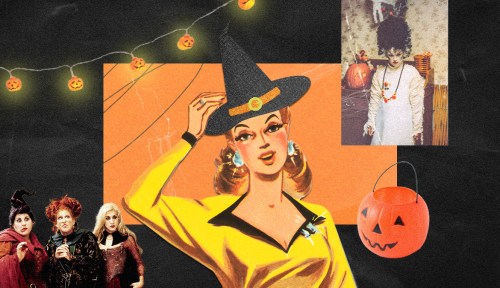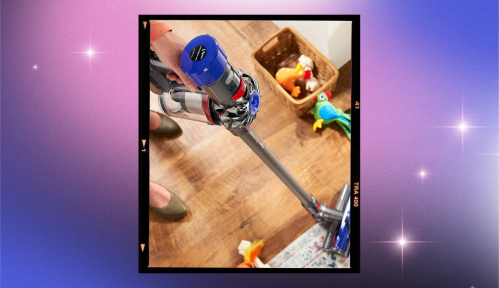Our editors independently select these products. Making a purchase through our links may earn Well+Good a commission
Before launching the Instagram page @halloweenhomemaker in 2016, Marsh Moon spent years connecting with other Halloween enthusiasts in online forums, where they were happy to discover they “weren’t the only weirdo” with the spooky holiday constantly on the brain. Their account, which now has more than 27,000 followers, features their massive vintage Halloween collection, which consists of 250-plus pumpkin pails and blow molds. “Halloween has always been something I’ve been able to look forward to and hold onto during the hardest times in my life,” they say, “so, I just wanted to find that comfort and magic every day.” And it turns out, they’re far from alone. A holiday once reserved for a single night of dressing up in costume has evolved into a cultural and commercial phenomenon for reasons much deeper than a scary getup might suggest.
Experts in This Article
associate professor of marketing at Yeshiva University
licensed psychologist and professor at Le Moyne College
According to the National Retail Federation, shoppers are expected to spend a record $12.2 billion on Halloween this year, exceeding last year’s record of $10.6 billion. Similar to the Christmas creep, Halloween merchandise has also been hitting store shelves earlier and earlier in recent years to facilitate the creation of an entire “spooky season,” in response to consumer demand.
On July 31, 2019, Target tweeted: “Tomorrow is August…so…it’s basically Halloween.” This year, Target, along with other retailers like Lowe’s and Home Depot, began selling Halloween wares in July. In fact, plenty of Halloween enthusiasts now consider July 5 the unofficial start of the spooky season since many see the Fourth of July as the last major holiday before fall. Upon spotting Halloween merchandise in stores for the first time each year, these eagle-eyed fans often use the phrase “code orange” to alert their kindred spirits that the time is nigh to replace your tiki torches with jack-o’-lanterns.
Just as the length of Halloween season has grown, so, too, have the product lines devoted to it. For example, just take the Bath & Body Works Halloween line of candles, decor, and bath products, which launched in 2015. This year, the collection includes a record 100 items, which is a 25 percent increase from last year, according to a company representative. Lush Cosmetics also offers a Halloween collection, which launched in 2009 with just four products, and has since grown to more than 30 limited-edition items. “We’ve seen a significant increase in Halloween sales over the past three years, with the range jumping from seven percent to 17 percent of our total sales during its period of availability,” says Julia Hamfelt, head of marketing and brand publishing for Lush Cosmetics North America. The Halloween fever has also spread to retailers you might not expect, like Ikea, which recently launched its first-ever Halloween collection, featuring ghost pillows and a tarantula-shaped tealight holder.
“Viral finds like the sherpa ghost pillows, pink ghost tumblers, and spooky purses…are sending shoppers into their local stores to hunt for themselves.” —Katie MacLeod, public relations manager at The TJX Companies, Inc
Over the years, sister stores HomeGoods, T.J. Maxx, and Marshalls have become a veritable ground zero for “code orange.” “This year, we’ve seen an influx of Halloween excitement on social media,” says Katie MacLeod, public relations manager at The TJX Companies, Inc (whose subsidiaries include the three stores above). Indeed, TikTok has run rampant with Halloween-themed videos like spooky shopping hauls, DIY ghost paintings, and summer-to-fall dorm transformations created by a growing subset of spooky influencers. “Viral finds like the sherpa ghost pillows, pink ghost tumblers, and spooky purses have amassed millions of views on TikTok and are sending shoppers into their local stores to hunt for themselves,” says MacLeod. Indeed, particular HomeGoods items that went viral on the platform this year—like a ghost blanket and a cauldron diffuser—sold out well before the leaves yellowed.
But the influence of social media on Halloween culture isn’t exactly new; millennials (ages 27 to 42) have been curating costumes via Pinterest and documenting Halloween shenanigans on Facebook, Instagram, and Snapchat for years. As they continue to be the generation spending the most on Halloween and driving its growth, psychology experts suspect that it isn’t just social media hype driving their interest and investment. A hefty dose of nostalgia could be behind the rising allure of Halloween, too.
Understanding the nostalgic appeal of Halloween
According to psychologist Krystine Batcho, PhD, whose current research focuses on nostalgia, the millennials at the forefront of the Halloween craze are at a pivotal time in life for nostalgia. “Research has shown that nostalgia is prominent during early adulthood, when a person has left childhood behind and has taken on the responsibilities of adulthood,” she says. “Trading off the carefree innocence of childhood for the burdens of independence can create considerable uncertainty and anxiety, which nostalgia can help alleviate by reviving feelings of security and comfort from an earlier time in life.”
Given that nostalgic memories are often centered on happy childhood experiences and social traditions, it makes sense that millennials would experience particular nostalgia around Halloween, says Dr. Batcho. The costume aspect just fuels that nostalgic fire. Dressing up is a way to “suspend reality to explore fantasy and the feeling of adopting a different identity,” she says.
There may be something especially joyful or freeing about getting to be whomever you want on Halloween—particularly for millennials, many of whom spent their formative years in a post-9/11 world and entered the workforce in the wake of the 2008 financial crisis, during the wars in Iraq and Afghanistan.
The current state of the world isn’t exactly pleasant, either; and the resulting sense of unease and uncertainty could also have millennials embracing nostalgia en masse, according to Jannine Lasaleta, PhD, an associate marketing professor at Yeshiva University who studies the connection between nostalgia and consumer behavior. “Millennials are consuming these [Halloween] things that reflect their childhood [as a way to add] some stability to such an unstable world,” she says.
“Millennials are consuming these [Halloween] things that reflect their childhood [as a way to add] some stability to such an unstable world.” —Jannine Lasaleta, PhD, associate marketing professor at Yeshiva University
It doesn’t hurt that these same millennials may have more buying power right now than they’ve ever had, adds Dr. Lasaleta. Many are at a point in life when they can, for example, “go to Halloween parties, and pay for their own parties in a way that they couldn’t when they were kids,” she says. And according to her research on nostalgia and consumer spending, the nostalgic element of Halloween may make it that much easier for millennials to part with their money for spooky expenditures, too (hence, the popularity of a $300 12-foot skeleton).
At the same time, “nostalgia is also associated with greater optimism, reaching out to others, and a greater sense of meaning and purpose,” says Dr. Batcho, which could explain the appeal of Halloween as something around which millennials tend to bond and find community.
In 2014, Ivonne Garcia, an artist in San Diego, CA, started a Halloween-themed Facebook group to share “code orange” finds with close friends. The members post photos of spooky items at stores like HomeGoods, World Market, and Trader Joe’s. While the group has grown, it is still small and private compared to other Halloween groups on Facebook. And Garcia says that’s for a reason: Members like to support one another’s shopping endeavors directly. “I’ve done it, and people have done it for me, where if you find something that I’ve posted about wanting, I’ll send you money to send it to me,” says Garcia.
Moon, the spooky influencer, shares a similarly positive sentiment on being a part of the year-round Halloween scene. “[It’s the] people who make it a fun and positive experience and create a real community where we’re uplifting and supporting one another,” they say.
That feels especially salient now in the wake of a pandemic that, for years, kept many of us from plenty of everyday pleasures and the company of others. “I think the pandemic gave people a lot of perspective about finding joy in things,” says Garcia. “If I want to buy pajamas that have, like, the Disney Villains on them, I’m going to because life is fleeting, and I want to enjoy things without judgment.”
Much in the same way, Halloween is the ultimate little (or big) treat for the nostalgic millennial. If simply doing spooky makeup with a ColourPop Haunted Mansion-themed makeup palette, or dressing up like Barbie brings joy, why wouldn’t we indulge?
Sign Up for Our Daily Newsletter
Get all the latest in wellness, trends, food, fitness, beauty, and more delivered right to your inbox.
Got it, you've been added to our email list.











